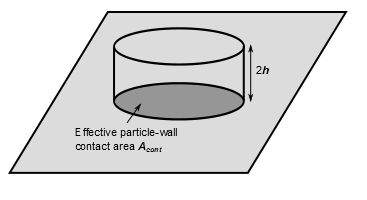When a liquid particle impinges a wall, the particle may deform and remain in direct contact with the wall for a short period of time before rebounding. During this time, heat is exchanged between the particle and the wall.
For droplet-to-wall heat transfer calculations, the Ansys Fluent discrete phase model assumes that the droplet deforms to a cylinder when impacting the wall (see Figure 12.16: Geometric Parameters of Deformed Impinging Droplet in Heat Transfer Calculations).
Then the heat transfer from the wall to the droplet is given as:
(12–349) |
|
where | |
|
| |
|
| |
|
| |
|
| |
|
| |
|
| |
|
|
The effective particle-wall contact area is calculated by time-averaging the particle-wall contact area assuming
a sinusoidal particle diameter variation from 0 to the maximum spreading
diameter
during contact period [65]. The maximum spreading diameter
is computed according
to [11] as:
(12–350) |
(12–351) |
|
where | |
|
| |
|
|
The contact time is calculated as [65]:
(12–352) |
|
where | |
|
| |
|
| |
|
|
The heat exchange between the wall and the particle is calculated
by integrating Equation 12–349 over the contact
time . The increase of the droplet temperature is limited by the boiling
point.
For each wall face, the particle-to-wall energy transfer is
computed by summing the energy contributions from all particle parcels
hitting the wall face and is then added to the heat flux of the wall.



